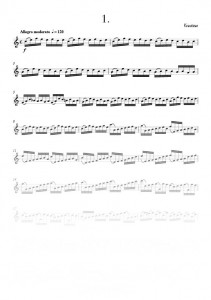Composed: 2006 Duration: 4 mins.
Instrumentation: Sax Tenor & Piano Level D
Exam Grade: AMEB Saxophone Tenor Grade 8,
HSC Saxophone Tenor
ISMN: M-720067-79-7 Catalogue: RM321
Level: D Country: Australia
Performed live by Lachlan Davidson
Sonata for Soprano Saxophone and Piano consists of three movements and is a long sustained chamber work for a duo. While I have termed this 29-minute work a sonata the individual movements of the work do not fit into sonata form in the traditional sense with an exposition, development and recapitulation. Note also that while the work has three movements, I have not followed the traditional fast - slow - fast tempos of the classical sonata, in fact all the movements tend to remain at fairly moderate speeds. The sonata here represents a major contribution in terms
of my compositional output.
In the past, stretching material over a long structure was difficult for me, thus this particular project served to develop my concept of structure. The sonata is therefore one of the longer works I have written. Subjects are stated by one instrument, then answered by the other. The opening of the third movement in particular makes use of the call and response technique. Overall, the work is heavily
influenced by modern jazz styles and modes.
Movement One was originally entered in the Allan Zavod classical/jazz fusion competition in May 2002. While my entry was not successful it was the impetus to writing the other two movements. The piece begins with a Dbmaj#11 chord and enters into a simple swung chord pattern that sets up the basic harmonic content for this movement. At bar 60 an important 12/8 and 2/4 pattern is established and minimalist techniques consisting of addition and subtraction of notes build the structure. It is interesting to note that the combined 12/8 and 2/4 bars equal 16 quavers, which in turn could be notated as two bars of 4/4. Even though the patterns fit into the common 4/4 pattern, it is the groupings that ultimately create the propulsion for this movement.
Milder than the first, Movement Two opens over a G pedal point in its second inversion. The movement is designed to be a ‘sweeter song’ than the first and similarly uses half and whole tone lateral steps as its primary movement between chords. At bar 99 a pattern reminiscent of the first
movement appears, though this pattern in C melodic minor is perhaps a little more ‘optimistic’ sounding than the first movement. Note that throughout the entire sonata there are concepts and ideas that cross all three movements.
Movement Three is much more energetic and is sustained by imitation and rapid movement contrasted with appropriate space. Attempts to explore colour are evident in the use of register transfer techniques and eventually the piece works itself towards a groove loosely based on funk rhythmic patterns beginning at bar 186. As with the other movements the opening statements return to complete the piece.
Performed by Rompduo
 These pieces have been chosen to give the advanced saxophonist a melodic selection of traditional studies and caprices. The works were adapted from the violin music of Kreuzter, Rode and Paganini and offer saxophonists the chance to play virtuosic studies that are immensely enjoyable - both to play and to listen to.
These pieces have been chosen to give the advanced saxophonist a melodic selection of traditional studies and caprices. The works were adapted from the violin music of Kreuzter, Rode and Paganini and offer saxophonists the chance to play virtuosic studies that are immensely enjoyable - both to play and to listen to.
Mastering one study at a time is a proven technique for learning these demanding pieces. Precision is vital. Detailed observation of pitch, rhythm and nuance is an effective way to begin the 20 pieces. Careful consideration of each fingering will help to develop fl uent integration of the altissimo register. Meticulous study now will save time and frustration later.
No breath marks are given and often no rests are present to indicate where to breathe. Given the wide variety of tempi that these studies are likely to performed at, each saxophonist must choose their own breathing points. Remember though that breathing is decided by the musical phrase, rather than the phrase being decided by the breathing. It is suggested that the occasional note be ommited to occomodate breathing rather than adjusting the tempo.
Given that most of the studies are intended to be played at a fast tempo, the exact metronome marking is left to the discretion of the player. However, several pieces are quite effective at a slower tempo and it is important to place accuracy above speed.
In most of the pieces, the articulations are taken directly from the violin. Use these original markings or explore additional patterns of your own choosing. Whatever the choice, a clear and consistent approach to articulation is recommended. All octave markings throughout this book are optional. These works are not intended solely for technical development but rather for the musical application of an already advanced technique.
For complimentary further study, Reed Music also publishes Barry Cockcroft’s book ‘Saxophone Technique’.